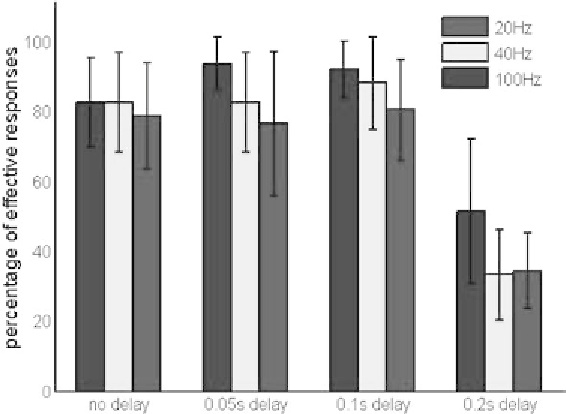Biology Reference
In-Depth Information
Fig. 8. Combined effects of different delays and noise. For short-but not for long-delays, the system is able to counteract
high-frequency noise. Bars in each group are sorted from left to right by frequency [Hz].
Biological and clinical experiments have shown that different behavioral stimuli can induce various
patterns of dopamine release (e.g., [25]). These patterns of neurotransmission can be simulated with
mathematical models that demonstrate the induction of different biochemical, cellular, and physiological
effects (Qi
et al
., submitted). Computational models of this type have so far not accounted for stochastic
noise, which must be expected to affect the dopamine signaling system on a regular basis. The consider-
ation of noise is not trivial, because the system is highly nonlinear, contains a fair number of molecular
components and in addition spans different time scales, which require the inclusion of time delays. The
resulting hybrid nature of the system is notoriously difficult to implement and analyze.
We have shown here that the combination of Biochemical Systems Theory (BST) with Hybrid Func-
tional Petri Nets (HFPN) affords us with a powerful method for exploring ill-defined hybrid systems.
BST requires only a minimum of assumptions for the representation of a biological system and offers
strong guidance for default settings and for the selection of parameter values [14]. These features are
crucial for designing models of a phenomenon like dopamine signaling that occurs deep within the
mammalian or human brain, where precise measurements are very difficult to obtain. While BST does
not
per se
allow delays and noise, BST models can be implemented with relative ease as HFPNs, which
subsequently permit the seamless integration of deterministic methods of systems analysis with delays,
switches, and stochastic effects [15,16].
Our HFPN simulations show that noise and delays can affect the signaling function of the dopamine
system in a significant manner. For instance, in situations of low-frequency noise and large delays at
the order of hundreds of milliseconds, the dopamine responses to signal trains may degrade into one
abnormally long response, thus impairing the normal functioning of the dopamine signaling system.
While the simulations show that noise and delays can corrupt a true signal, our results also show
that the signaling system is surprisingly robust. Most processes involved in the dopamine dynamics are
fast events such as biochemical reactions and ion fluxes, which occur at the order of a few or tens of
milliseconds, while the important transport and release of dopamine into the cleft is somewhat slower.
Much of the noise associated with small numbers of molecules contributing to the governing reactions

